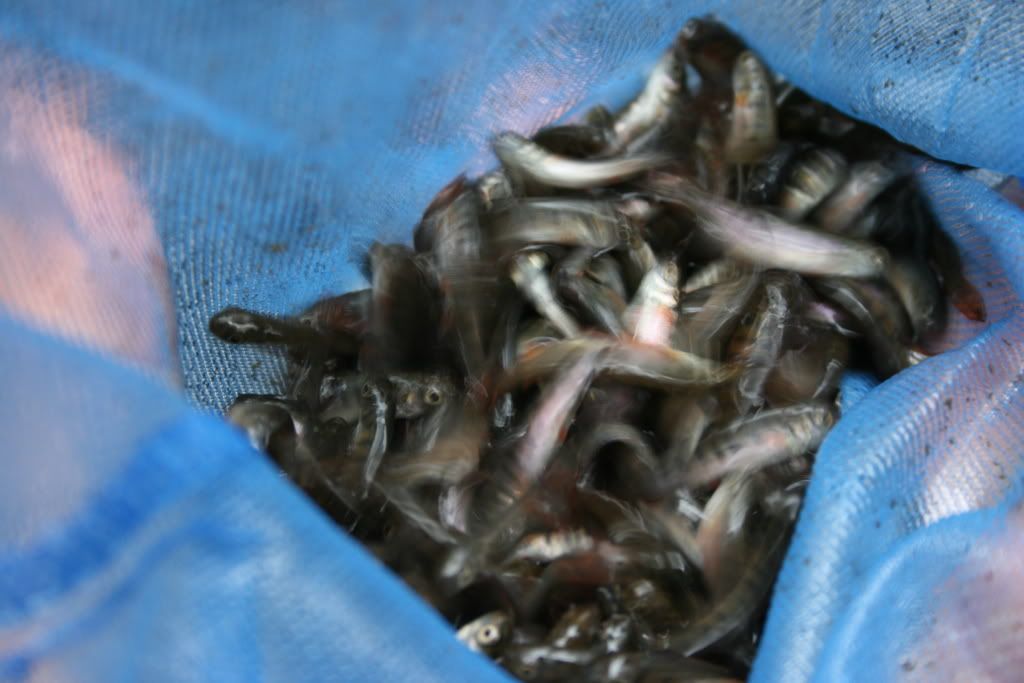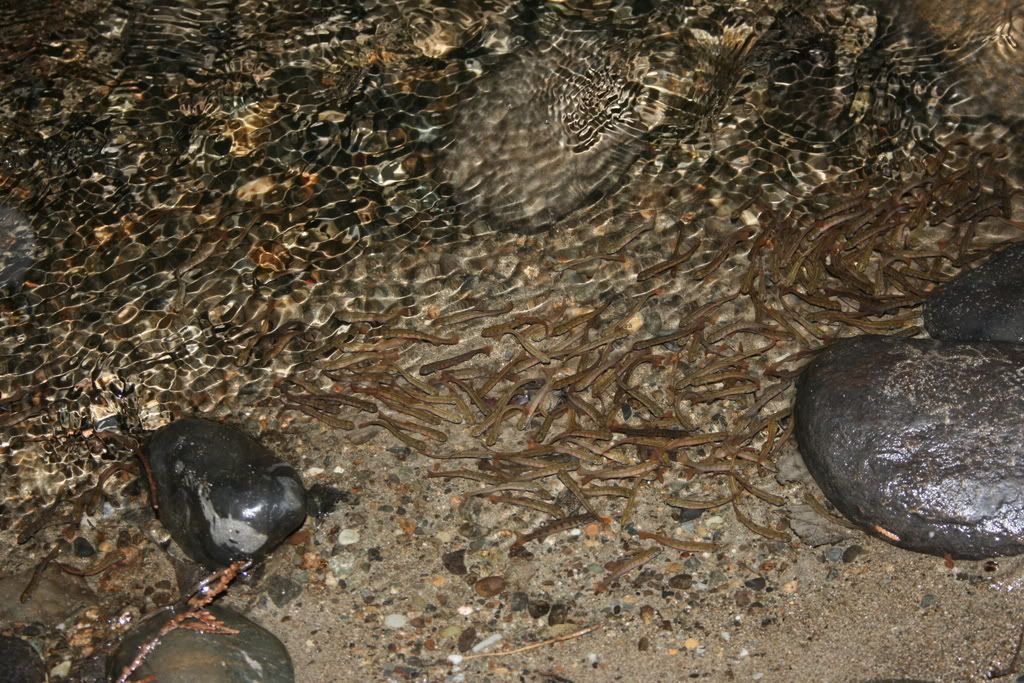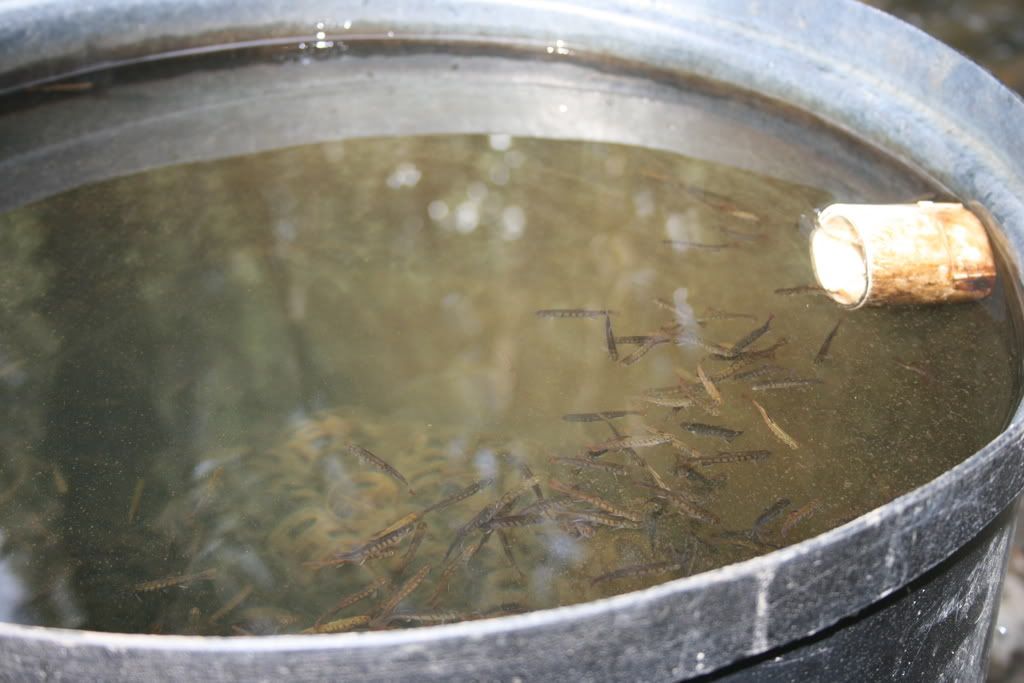Once I got down to the incubator around 11:45 Saturday morning, I opened the lid to see what I could see. The little guys looked really good.

As a coho fry changes from being an alevin, it starts to build the muscles that will become its body. These start to grow from the spine and gradually get bigger and thicker, eventually growing around the shrinking yolk sac that they are subsisting on (which is also turning into their digestive tract). When the two sides of the fish are closed up, or are within 1 mm of closing, they are ready to be released. Keeping them in the incubator for any longer is not good for them; they'll be overcrowded and with their food source gone and not that much food available in the water cycling through the barrel, they will start to prey on one another. So I dipped my new net into the water and pulled out a handful of fry for closer inspection. This is what I saw:

As you can see, their bellies are all closed up. They are ready to go. By this time, lots more of the curious fellows were rising up to the top of the incubator to get a look at what was going on. This seems like a lot of fish; really though, it isn't. Wait 'til you see how many fish were actually there.

I could have released them right then, but I didn't. It was mid-day with several hours of light left. In years passed, I have generally released the fish in the early morning. This was mostly due to convenience; I have a job to get to and I usually don't get home until dark or soon after, not the best time for spending an hour or so beside McAleer Creek. I wanted to be around to see them go and Claire and I were going to be leaving to go to the UW basketball game in just a few minutes. The game would end around 4:30, so we could get home around 5 and release them with about an hour of daylight left. This would allow most of them to get into the creek during the night, safe from most predators. I love how the fish look at this point; their fins and tails are very delicate looking and are a lovely shade of red. These guys want to go, NOW.

On our way home from the game it started to snow. It was just a small flurry, but by the time we got home there was a coating atop the incubator.

I pulled the top off the incubator. This is the last time the incubator will have the screen on it until next winter just after I put the new 'eyed' eggs into the barrel.

Once the exit screen is removed, water starts to flow more quickly through the incubator. The fry notice the change in the current and begin to rise up out of the bottom.

Within a couple of minutes, there are significantly more fish than you thought the barrel would hold.

Coho salmon fry, like most other fish, orient themselves locally by facing into the current. This makes it easier for them to breathe (they just have to open their mouth) and eat (they just have to open their mouth and swallow). In a sense, you can get a good idea of the currents in the water by looking at how they are oriented. They're like iron filings responding to the forces generated by a magnet.

Because it was getting darker I began to use the flash on my camera. That's why the coloring of the fish changes (and you can see a bright spot on the water, probably a reflection of the flash).

The fry seem almost schizophrenic; on the one hand, they want to get out into the creek, on the other, they seem to resist the pull of the current. Most of them are already strong enough swimmers that they are able to resist the current generated at the mouth of the exit pipe.

The ones who face into the current can swim against it fine. The ones at an angle to the current entering the exit pipe get sucked down and out.

Once out of the exit pipe, the fry begin to collect along the sides of the creek. They are too small to resist the flow of the creek anywhere near the middle, so they automatically head for the sides and begin to accumulate in the nooks and crannies. The local salmon gurus encourage people to leave the sides of creeks running through their property in a natural state; this gives the young fry lots of habitat in which to hide. As you can see, they blend in pretty well with the sand and gravel at the bottom of the creek. These little guys are hiding beneath a cedar tree growing right alongside the incubator exit pipe.

They take advantage of any small space and begin to congregate there. Parts of the creek that run through my front yard are lined with broken slabs of concrete; old sidewalks or driveways that are now serving another purpose. They control erosion along the bank, but because of their irregular nature, they also provide hiding places for baby fish. Look closely and you will see several fry in this picture.

So, as dusk turned to full dark, we put the lid back on the incubator and allowed all those thousands of fry to slide quietly into the night.
This afternoon, Sunday, March 8, I went down to the incubator to check on the progress of the release. It's a process that happens over time; alot of the fish go out in the first hour or so, but many of them stay in the incubator for quite a while longer. I knew that there would still be fry in the barrel this afternoon and I was not disappointed in that.

On first inspection, it doesn't seem there are that many. Two things have happened; first, there are nowhere near as many as there were yesterday, but second, the fry have been in relative darkness with the lid on the incubator. When I removed the lid, they dove for the bottom and their hiding places.
Once they settled down a bit, they came rising up to check things out.

I watched them for a little while and saw that there are probably a couple hundred fish still in the incubator. Most of them will leave its safety over the next week. I can pretty much guarantee that when I look inside in a couple of weeks, there will still be fish in there. Some of those guys like it in there and with 60,000+ of their brothers and sisters now having vacated the premises, there's more room to move around and probably enough food to go around.

The water is running clean and clear. One thing I noticed in the picture above is the little bits of algae floating in the water. The fry will eat that for a while and then eventually graduate to eating little bugs in the water. With so few fish, there seems to be more than enough food in there for the time being. Because there is very little insect life in the barrel, the fry will have to go out to the creek for food at some point in the future. They're welcome to hang around for as long as they need to.
This has been a relatively successful year. Out of the 70,000 'eyed' eggs we put into the incubator on December 10, probably 64-65,000 of them have grown to the fry stage and most of them have been released into McAleer Creek.
Coho salmon overwinter in their birth creek. That means that they are born in the winter of one year (like 2008/09), but will stay in the creek for a full year and leave the next spring (2010). Those that survive that long will be about 6 - 9" long and ready to go out through Lake Washington, the Mountlake cut, Lake Union and the Ship Canal, through the Ballard Locks, and out into Puget Sound. Those that make it through that gauntlet will head up to the Gulf of Alaska for a couple of years and return in 2013 or 2014. Less than 1% are likely to return. If 1% did, then 640 or 650 fish would be swimming up McAleer Creek. That would be a noticeable improvement on what we have today.
I'll keep doing this as long as the State Department of Fisheries continues to give me eggs. It's fun. I enjoy playing in the water and I like having a positive effect on the environment. Even if very few fish come back, there are a lot of other animals that are happy; kingfishers, great blue herons, Dolly Varden trout, seals, sea lions, orcas. Though I have now been doing this for 10 of the last 11 years, I never tire of the mysteries of growth and life contained in that black barrel; my wild salmon incubator.
2 comments:
Two questions, in sequence:
1) Any plans for a second incubator? :)
2) With a second 'bator, would the state give you more eggs, or have you pretty much met your quota?
Just curious. Wish I lived on a stream and could do that!
Mind if I share this post with westseattleblog.com, as there is a stream over here that could use help, and maybe one of their readers would see it and get an idea.
1) No plans for a second incubator. The first one will actually hold 125,000 eggs in all, but WDFW (Wash. Dept of Fish and Wildlife) has determined that 70,000 is the carrying capacity of the portion of McAleer Creek that runs between my house and Lake Washington. The fry released this past weekend will swim upstream a bit, though they won't get past a rather significant riffle about 50-60' upstream. Most of them will follow the path of least resistance and head downstream. When I go out along the creek now, everywhere I look I see little salmon fry hanging out in along the edges of the creek. It's really cool.
2) I'm raising all the fish they'll give me. If they would give me more, I'd raise more.
I love talking/writing about this. I started my professional life as a classroom teacher. One of my subjects was outdoor education, so I've studied/read/observed this stuff in the PNW since 1975 when I arrived here from Connecticut. If there are folks that want to get started with this, I'd be glad to help them in any way I can.
Post a Comment